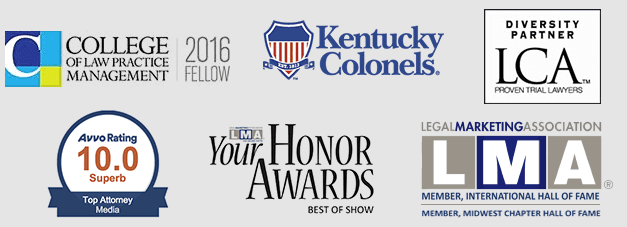Using Marketing tools to aid Lateral Recruiting.
Last week in Part 1, we discussed how law firms can increase their lateral-hiring results by building their brand within the legal community. If you show your style, approach, or culture, or find a way to offer something more or look like a better alternative, the professionals who are seeking that thing will volunteer to work at your firm.
Here’s an example from last week’s post about Levenfeld Pearlstein:

This has the additional benefit of screening out those who may be skilled lawyers but aren’t a good fit for your firm. If your firm is a “round hole,” clearly expressing the type of person who fit your system will help avoid attracting ill-fitting “square pegs.” Those bad hires are short-timers, and making bad hires is costly, disruptive, and inefficient.
That is, you don’t just hire more people, you hire more of the right people. BTW, it works for law students too.
I think Sidley gets it.

At the height of the business boom, they announced that they were offering something more to their associates―an impressive-sounding leadership and executive-training program conducted through top universities (that counts toward their billable-hour requirement). According to “Above the Law”:
“[A]ssociates will have access to executive leadership programs at business schools such as Harvard, Columbia,… Which is in addition to internal executive leadership academies focused on business, client, and professional skills. As they move through the program, they’ll also be afforded the opportunity to work on ‘hands-on passion projects’.”
Why it works:
I can’t vouch for Sidley’s program, but it was brilliant from a marketing and recruiting perspective:
First, it helps brand Sidley among clients and prospects as a progressive firm whose lawyers have a greater understanding of real-world business than their competitors.
Next, it will proactively attract the type of lateral associates they want, i.e. those who would value having a practical business education.
And finally, it locks in the top Sidley associates who are participating in the program, increasing retention. (Oh, and presumably it’ll teach them valuable professional skills too, but that’s almost beside the point.)
Do something great. Then tell EVERYONE.
Sidley cranked up their public relations machine to persuade prominent publications to write about their new program, e.g. Above the Law, Reuters, Law.com, Law360, and other popular sites. That’s the type of initiative I’m talking about! There are so many innovative new recruiting ideas to explore―low-hanging fruit just waiting to be plucked off the tree. If only firms would execute.
Other law firms may start offering their own leadership programs, but Sidley will have earned first-mover advantage, an 8-12-month head start, and all of the publicity. (The media doesn’t waste many column inches proclaiming that more firms are offering the same program they detailed a year earlier. That’s not news.)
Kirkland gets it too.
Not long after Sidley’s announcement, Kirkland & Ellis made its own bold move toward associate recruiting and retention, shortening the firm’s partnership track by a year:

“‘A shorter partnership track may bolster Kirkland’s appeal to senior associates at other firms and may prompt senior associates and non-equity partners already at Kirkland to think twice before leaving,’ said Kate Reder Sheikh, managing director of the associate practice group at legal recruiter Major, Lindsey & Africa.”
“I think every firm right now should be thinking about ways to make themselves appealing,” Sheikh said. “The partnership track is one of those levers they can pull.” Exactly.
Orrick and Sheppard Mullin
Orrick and Sheppard Mullin give billable time to “unplug and recharge.”
According to Above the Law,
“The firm offered everyone (i.e., staff, associates, of counsel, career associates, and partners) the chance to truly ‘unplug’ by crediting up to 40 hours of bonus-eligible time for everyone to sit back, relax, and simply stop doing work. Many Biglaw firms talk a good game about mental health and wellness, but Orrick was the first firm (that we know of) to offer bonus-eligible hours dedicated to taking time off work. Now, almost one year later, [Sheppard Mullin] is following in Orrick’s footsteps.”
It’s a simple idea really, but one designed to help refresh some stressed-out, burned-out associates, many of whom could be seeking some light at the end of the tunnel before they stagger away to a competitor or out of the profession entirely.
The firms are not paying additional cash, they’re just giving the associates 40 hours of billable credit for the time they spend off duty. (It feels like they’ll make up the hours―the work will still get done, the hours will still get billed.)
But a one-week paid sabbatical in those extraordinary times might have kept some from leaving. That’s cheaper than paying a 30% headhunter fee on every $400,000 associate, and much less disruptive.
More good ideas, Quinn and Mintz
Other new ideas included Quinn Emanuel allowing their lawyers to work full-time from home. Mintz Levin, et al. updated its Compassionate Leave Policy “for losses including miscarriage, failed surrogacy, adoption, or fertility treatment.” Don’t you want to work at a firm that seems that caring? Nicely done, Mintz.
Headhunter fees are costly one-offs.
Building your brand lasts for YEARS.
Most importantly, building a persuasive brand that will linger for many years is an investment in the firm’s future. That requires an innovative strategy, followed by an effective use of marketing and branding tools to spread the word, e.g. print and online advertising, social media, professional announcements, direct mail, etc.
And in my experience, if done right, you’re also attracting the right lawyers―the ones who best fit your culture and are most likely to succeed within your system.
Law.com Update
Here’s a December, 2021 Law.com article discussing “the frantic war for talent” that mentions some of these same recruiting incentives, opening with the biggest incentive, CASH:
“The most ubiquitous strategy in Big Law was simply offering attorneys, especially associates, more money in order to entice them to stay or join their firm.”
Perhaps the scariest takeaway from the article was one recruiter’s comment that inadequate recruiting is costing big firms “tens of millions of dollars”:
“And the downside of not having enough talent is more costly. Suzanne Kane, a partner at Macrae, told Law.com reporter Jessie Yount in October that one partner estimated the loss of business due to not having enough attorneys to staff matters at 15% to 20% of the revenue the firm could have generated this year.
“’Firms that have lost associates are desperate. It’s affecting their year to the tune of tens of millions of dollars,’ Kane said.”
April 12, 2022 update:
Some firms went a step further, according to an article in the ABA Journal entitled, “Law firms increasingly offer the title of partner to lure lateral associates”:
“Law firms ‘needed bodies,’ said Adam Oliver, CEO and co-founder of Firm Prospects, in an interview with Law360. ‘The only way they could get people to jump ship was to offer partnership on day one.’”
May 19, 2022 update:
I saw this Quinn Emanuel advertisement in a national legal blog. The firm’s new “Work from Anywhere” policy had garnered significant publicity and once the media stopped writing about it, Quinn started pushing it out with paid ads to its target lawyer audience. Smart.
So, it begs the question―with stakes this high, why aren’t more firms supporting their recruiting with better marketing?
————————
Need to enhance your OWN Marketing and Recruiting? Call or text Ross NOW at 847.921. 7677!
Contact Ross Fishman directly for more information at +1.847.921.7677 or ross@fishmanmarketing.com
For more info, download a free copy of the definitive law firm branding book, “We’re Smart. We’re Old. And We’re the Best at Everything. The World’s First No-BS Guide to Legal Marketing and Branding,” paperbacks are available at Amazon here.




